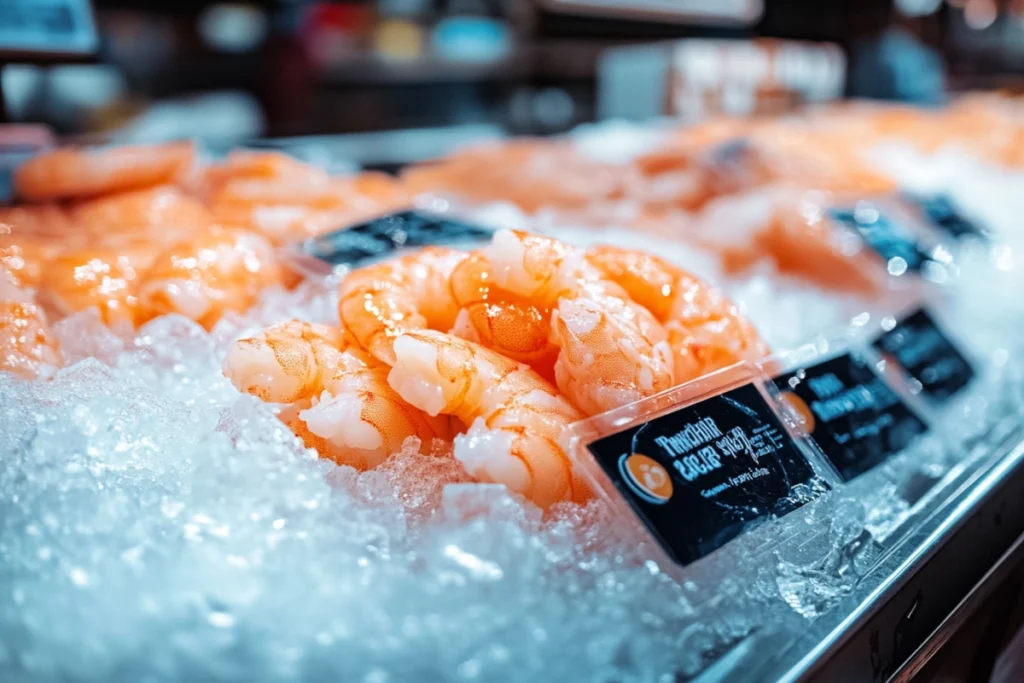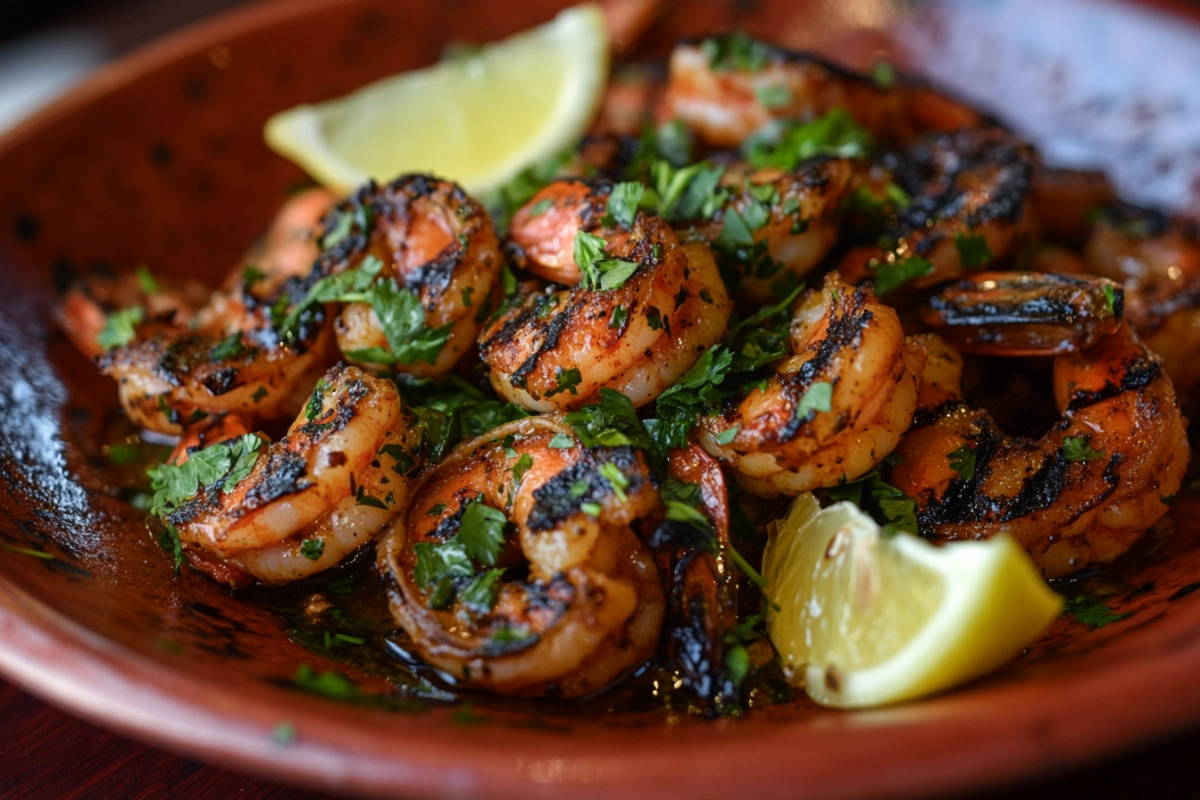Tiger shrimp, renowned for their distinctive flavor, jumbo size, and versatility in gourmet dishes, often come with a hefty price tag. But why is tiger shrimp so expensive? From farming challenges and environmental impacts to global demand and premium quality, several factors contribute to their high cost. This article delves into the reasons behind their pricing, exploring their culinary appeal, sustainability efforts, and health benefits. Let’s uncover the full story of these luxurious crustaceans!
Understanding Tiger Shrimp
What Are Tiger Shrimp?
Tiger shrimp, also known as black tiger shrimp, are a species of prawn celebrated for their large size, striking striped shells, and tender meat. Native to the warm waters of the Indo-Pacific, they thrive in coastal and estuarine environments. These crustaceans can grow significantly larger than other shrimp varieties, with some reaching lengths of up to 13 inches.
Their size isn’t just for show—it plays a big role in their culinary value. Chefs favor tiger shrimp for their ability to absorb flavors while retaining their natural sweetness. This makes them a staple in luxurious dishes like garlic butter shrimp, tempura, and grilled seafood platters.
Key Differences Between Tiger Shrimp and Other Shrimp Varieties
When comparing tiger shrimp to other types, like white shrimp or vannamei shrimp, several standout features justify their premium pricing. Tiger shrimp have a firm texture, which holds up better in diverse cooking methods, from sautéing to grilling. Their bold stripes and vibrant shell color also add visual appeal, making them a showstopper on plates.
Moreover, tiger shrimp boast a richer, meatier taste than smaller shrimp varieties, making them a favorite in gourmet cuisine. This exceptional flavor profile stems from their natural habitat and diet, which includes algae and organic matter, giving their meat a slightly briny undertone.
Tiger shrimp’s exquisite flavor, impressive size, and visual appeal make them a premium product in the seafood market. However, these attributes are only part of the equation. In the next section, we’ll explore the economic factors that make these crustaceans so costly. Ready to learn more? Let’s dive in!
Economic Factors Driving Prices
High Production Costs
Producing tiger shrimp is a resource-intensive endeavor. From the start, farmers face significant costs in maintaining suitable aquaculture facilities. These crustaceans require large ponds with precise water quality and temperature controls to thrive. The feed is another major expense—tiger shrimp are typically fed high-protein diets, which are more costly than the diets for other shrimp species.
Disease management is yet another challenge that adds to the price. Outbreaks of diseases like White Spot Syndrome can devastate shrimp farms, leading to substantial financial losses. Preventing such diseases requires continuous investment in biosecurity measures, vaccinations, and frequent health monitoring, all of which drive up costs.
Global Demand and Supply Dynamics
Tiger shrimp enjoy a reputation as a premium seafood product, creating a mismatch between demand and supply. Global seafood consumption has surged in recent years, particularly in markets like the United States, Europe, and Asia. Yet, the availability of tiger shrimp remains limited due to the lengthy growth cycle compared to other shrimp varieties.
Moreover, competition among major producing nations, including India, Vietnam, and Indonesia, adds another layer of complexity. While producers aim to meet international demand, they struggle with fluctuating prices for raw materials and shipping, exacerbated by trade policies and currency variations. This imbalance between supply and demand helps explain why tiger shrimp are so expensive.
Environmental and Ethical Considerations
Impact of Farming on Ecosystems
The farming of tiger shrimp isn’t without its environmental downsides. Many farms are located in mangrove regions, which are often cleared to create aquaculture ponds. Unfortunately, this deforestation disrupts local ecosystems, affecting both biodiversity and coastal protection. Such environmental costs indirectly inflate the price of shrimp as stricter regulations and environmental penalties increase production expenses.
Water pollution is another issue. Shrimp farming generates significant amounts of organic waste, which can lead to eutrophication if improperly managed. To mitigate these effects, farms must invest in wastewater treatment systems, further driving up the cost.
The Role of Sustainable Practices
As consumers become more environmentally conscious, the demand for sustainably farmed tiger shrimp has risen. Certifications like the Aquaculture Stewardship Council (ASC) label assure buyers that the shrimp are produced with minimal ecological impact. However, meeting these stringent standards involves higher costs for farms. Producers must implement eco-friendly practices, such as using alternative feeds, reducing chemical usage, and maintaining strict water quality protocols.
Incorporating sustainability into farming not only supports ethical consumption but also enhances the premium positioning of tiger shrimp in the global market. This trend highlights a critical reason why tiger shrimp are so expensive: consumers are willing to pay extra for ethically sourced seafood.
For more insights on shrimp farming challenges and sustainable practices, you might find this guide on tiger shrimp farming useful! Let me know if you’d like me to refine or expand any part of the content.

Transportation and Logistics
Cost of Export and Import
One of the lesser-discussed reasons why tiger shrimp are so expensive is the logistics involved in getting them from farms to markets. Tiger shrimp are highly perishable, requiring careful handling and temperature-controlled storage throughout the supply chain. This means producers must invest in advanced refrigeration and packaging to maintain their premium quality.
Additionally, international trade policies and tariffs can significantly impact pricing. For example, high import taxes or fluctuating fuel prices increase shipping costs, which are passed down to the consumer. For shrimp exported to far-off markets like North America or Europe, these expenses can account for a substantial portion of the final retail price.

Challenges in Maintaining Quality During Transport
Preserving the quality of tiger shrimp during transit is no small feat. These delicate crustaceans need to be frozen or chilled immediately after harvest to prevent spoilage. Advanced freezing technologies, such as IQF (Individually Quick Frozen), are often used to lock in freshness, but they come with steep costs.
Moreover, delays in transport, whether caused by logistical bottlenecks or customs inspections, can compromise product quality. To minimize risks, many suppliers opt for air freight over sea freight. While faster, air shipping is far more expensive, further driving up the cost of tiger shrimp on store shelves.
For more insights on seafood logistics and recipes, check out this guide on tiger shrimp.
Market and Culinary Appeal
Premium Positioning in Global Markets
Tiger shrimp have earned their reputation as a luxury seafood item. Their size, rich flavor, and visual appeal make them a preferred choice for premium restaurants and upscale grocery stores. As a result, tiger shrimp are often marketed as a high-end product, commanding higher prices.
Global food trends also influence their positioning. In many cultures, serving tiger shrimp at celebrations and special occasions symbolizes abundance and luxury. This cultural significance enhances their perceived value, allowing producers to maintain their premium pricing.
Tiger Shrimp in High-End Cuisine
Chefs worldwide adore tiger shrimp for their versatility in the kitchen. Their firm texture and mild sweetness complement a wide range of cuisines, from Asian stir-fries to Mediterranean grilled platters. Their impressive size also makes them ideal for eye-catching dishes like shrimp skewers or stuffed shrimp.
In high-end dining, presentation matters. The striped shell and vibrant color of tiger shrimp elevate the visual appeal of dishes, making them a favorite for gourmet plating. Their adaptability to bold flavors, like garlic butter, chili, or fresh herbs, adds another layer of desirability.
Tiger shrimp’s culinary charm and market prestige are among the strongest drivers of their high prices. In the next section, we’ll look at what the future holds for these luxurious crustaceans. Interested in exploring unique shrimp recipes? Consider checking out this recipe collection.
The Future of Tiger Shrimp
Trends in Production and Consumption
The future of tiger shrimp looks promising as advancements in aquaculture continue to reshape the industry. Producers are increasingly adopting innovative farming methods, such as recirculating aquaculture systems (RAS) and biofloc technology, to boost production while reducing environmental impacts. These techniques allow for more efficient use of resources, potentially bringing down costs over time.
On the consumer side, demand for tiger shrimp is expected to rise, particularly in emerging markets. As disposable incomes grow and global cuisines become more accessible, more people are discovering the unique taste and culinary versatility of tiger shrimp. However, this increasing demand could further strain supply chains, keeping prices high in the short term.
Potential for Price Stabilization
Efforts to stabilize the cost of tiger shrimp are gaining momentum. Governments and international organizations are supporting sustainable aquaculture practices through subsidies and training programs. Additionally, research into alternative feeds, such as plant-based proteins, could reduce dependency on expensive fishmeal, lowering production costs.
Even so, tiger shrimp will likely remain a premium product due to their luxurious appeal. As consumers prioritize quality and sustainability, they may be willing to pay a premium, ensuring tiger shrimp retain their high-end status. This delicate balance highlights a core reason why tiger shrimp are so expensive—their unmatched combination of quality, rarity, and market appeal.
FAQs
Why is tiger shrimp preferred over other shrimp varieties?
Tiger shrimp stand out because of their impressive size, firm texture, and sweet, mild flavor. These qualities make them perfect for high-end dishes, where presentation and taste matter most. Their visual appeal, with bold stripes, also adds to their desirability.
Are tiger shrimp sustainable?
Sustainability depends on farming practices. Many producers are now seeking eco-certifications, like ASC, to meet consumer demand for ethically sourced seafood. However, traditional farming methods can still have significant environmental impacts.
Why do tiger shrimp cost more than white shrimp?
Tiger shrimp are larger, take longer to grow, and require specialized farming techniques. Additionally, their global demand outstrips supply, driving up prices. Transport and storage costs for maintaining their freshness also contribute to their higher price point.
What are the best ways to cook tiger shrimp?
Tiger shrimp are incredibly versatile. They can be grilled, sautéed, baked, or even served in soups and curries. Their firm texture holds up well to bold flavors like garlic butter, chili, or lemongrass. For recipe inspiration, consider exploring shrimp dishes on culinary sites.
With this detailed exploration of tiger shrimp, we hope you now understand why tiger shrimp are so expensive. From their farming challenges to their premium positioning, these crustaceans are a testament to the art of aquaculture. If you’re curious about other seafood delicacies, don’t hesitate to dive into more guides and recipes!
Health Benefits of Tiger Shrimp
Rich in Nutrients
Tiger shrimp aren’t just delicious—they’re also a powerhouse of essential nutrients. Packed with high-quality protein, these crustaceans help support muscle growth and repair. They’re also a great source of omega-3 fatty acids, which promote heart and brain health. Additionally, tiger shrimp are low in calories and saturated fat, making them an ideal choice for those watching their diet.
They contain vital vitamins and minerals like vitamin B12, selenium, and zinc, all of which contribute to immune function, energy production, and overall well-being. These health benefits add to their allure, reinforcing why tiger shrimp are so expensive. Consumers are often willing to pay more for a product that combines taste and nutritional value.
Nutritional Content (Per 100g)
Below is the nutritional breakdown of tiger shrimp per 100g serving:
| Nutrient | Amount | % Daily Value* |
|---|---|---|
| Calories | 99 kcal | 5% |
| Protein | 24 g | 48% |
| Fat | 0.3 g | 0% |
| Omega-3 Fatty Acids | 0.3 g | 15% |
| Selenium | 40 mcg | 73% |
| Vitamin B12 | 1.2 mcg | 20% |
| Zinc | 1.5 mg | 10% |
*Percent Daily Values are based on a 2,000-calorie diet.
Allergen-Friendly and Versatile
Interestingly, tiger shrimp are also a great seafood option for many allergy-sensitive individuals, as they’re naturally gluten-free. This versatility makes them an excellent addition to a variety of diets, including keto, paleo, and low-carb plans. Their adaptability to diverse culinary styles—from Asian curries to Mediterranean grills—further enhances their popularity.
These combined health benefits and culinary flexibility elevate tiger shrimp above other seafood choices. Their premium status isn’t just about flavor but also about offering consumers a guilt-free indulgence.
How to Choose and Store Tiger Shrimp
Selecting Fresh Tiger Shrimp
Choosing high-quality tiger shrimp can make or break your cooking experience. Look for shrimp with firm, translucent shells and a slightly briny aroma. Avoid any that have a strong, fishy smell, as this indicates spoilage. Fresh tiger shrimp often have vivid stripes and a glossy appearance, reflecting their freshness.
If you’re buying frozen tiger shrimp, ensure the packaging is sealed and free from ice crystals. These crystals may indicate that the shrimp have been thawed and refrozen, compromising their quality. Making informed choices at the store ensures you get the best flavor and texture.
Storing and Preparing Tiger Shrimp
To keep your tiger shrimp fresh, store them in the coldest part of your refrigerator and use them within one to two days. If freezing, place them in an airtight bag to prevent freezer burn. Proper storage not only preserves their taste but also protects your investment—after all, why are tiger shrimp so expensive if not for their premium quality?
Before cooking, rinse the shrimp thoroughly under cold water and devein them, if necessary. Whether grilling, sautéing, or steaming, tiger shrimp cook quickly, making them a convenient yet luxurious ingredient for weeknight meals or special occasions.
Tiger shrimp’s nutritional value, quality, and proper storage methods all contribute to their high status in the seafood world. Ready to cook up some inspiration? Consider exploring delicious tiger shrimp recipes to bring out their best flavors!

